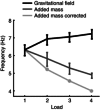Increased gravitational force reveals the mechanical, resonant nature of physiological tremor
- PMID: 26108915
- PMCID: PMC4594250
- DOI: 10.1113/JP270464
Increased gravitational force reveals the mechanical, resonant nature of physiological tremor
Abstract
Key points: Physiological hand tremor has a clear peak between 6 and 12 Hz, which has been attributed to both neural and resonant causes. A reduction in tremor frequency produced by adding an inertial mass to the limb has usually been taken as a method to identify the resonant component. However, adding mass to a limb also inevitably increases the muscular force required to maintain the limb's position against gravity, so ambiguous results have been reported. Here we measure hand tremor at different levels of gravitational field strength using a human centrifuge, thereby increasing the required muscular force to preserve limb position without changing the limb's inertia. By comparing the effect of added mass (inertia + force) versus solely added force upon hand acceleration, we conclude that tremor frequency can be almost completely explained by a resonant mechanical system.
Abstract: Human physiological hand tremor has a resonant component. Proof of this is that its frequency can be modified by adding mass. However, adding mass also increases the load which must be supported. The necessary force requires muscular contraction which will change motor output and is likely to increase limb stiffness. The increased stiffness will partly offset the effect of the increased mass and this can lead to the erroneous conclusion that factors other than resonance are involved in determining tremor frequency. Using a human centrifuge to increase head-to-foot gravitational field strength, we were able to control for the increased effort by increasing force without changing mass. This revealed that the peak frequency of human hand tremor is 99% predictable on the basis of a resonant mechanism. We ask what, if anything, the peak frequency of physiological tremor can reveal about the operation of the nervous system.
© 2015 The Authors. The Journal of Physiology published by John Wiley & Sons Ltd on behalf of The Physiological Society.
Figures











References
-
- Cannon SC & Zahalak I (1982). The mechanical behavior of active human skeletal muscle in small oscillations. J Biomech 15, 111–121. - PubMed
-
- Clarys JP & Marfell‐Jones MJ (1986). Anthropometric prediction of component tissue masses in the minor limb segments of the human. Hum Biol 58, 761–769. - PubMed
-
- Clauser CE, McConville JT & Young JW (1969). Weight, volume and center of mass of segments of the human body. Aerospace Medical Research Laboratory (U.S.). Technical report.
-
- De Leva P (1996). Adjustments to Zatsiorsky‐Seluyanov's segment inertia parameters. J Biomech 29, 1223–1230. - PubMed
-
- Drillis R, Contini R & Bluestein M (1964). Body segment parameters. A survey of measurement techniques. Artif Limbs 8, 44–66. - PubMed
Publication types
MeSH terms
Grants and funding
LinkOut - more resources
Full Text Sources
Medical

